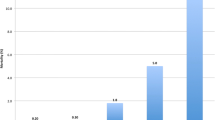Abstract
This paper examines the empirical consistency of the Diagnosis Cost Groups/Hierarchical Condition Categories (DCG/HCC) risk-adjustment method for comparing 7-day mortality between hospital-based outpatient departments (HOPDs) and freestanding ambulatory surgery centers (ASCs). We used patient level data for the three most common outpatient procedures provided during the 1997–2004 period in Florida. We estimated base-line logistic regression models without any diagnosis-based risk adjustment and compared them to logistic regression models with the DCG/HCC risk-adjustment, and to conditional logit models with a matched cohort risk-adjustment approach. We also evaluated models that adjusted for primary diagnoses only, and then for all available diagnoses, to assess how the frequently absent secondary diagnoses fields in ambulatory surgical data affect risk-adjustment. We found that risk-adjustment using both diagnosis-based methods resulted in similar 7-day mortality estimates for HOPD patients in comparison with ASC patients in two out of three procedures. We conclude that the DCG/HCC risk-adjustment method is relatively consistent and stable, and recommend this risk-adjustment method for health policy research and practice with ambulatory surgery data. We also recommend using risk-adjustment with all available diagnoses.



Similar content being viewed by others
Notes
Complete estimation results are available in the appendix.
References
Iezzoni LI (1997) The risks of risk adjustment. JAMA 278(19):1600–1607. doi:10.1001/jama.278.19.1600
Romano PS, Mark DH (1994) Bias in the coding of hospital discharge data and its implications for quality assessment. Med Care 32(1):81–90. doi:10.1097/00005650-199401000-00006
Jencks S, Williams D, Kay T (1988) Assessing hospital-associated deaths from discharge data. The role of length of stay and comorbidities. JAMA 260(15):2240–2246. doi:10.1001/jama.260.15.2240
MedPAC Medicare Payment Advisory Commission Report to Congress: Medicare Payment Policy (2004). Washington, DC. p. 203–219
Coldiron B, et al (2005) Adverse event reporting: lessons learned from 4 years of Florida office data. Dermatol Surg 31(9 Pt 1):1079–1092. discussion 1093
Fleisher LA, et al (2004) Inpatient hospital admission and death after outpatient surgery in elderly patients: importance of patient and system characteristics and location of care. Arch Surg 139(1):67–72. doi:10.1001/archsurg.139.1.67
Fleisher LA, Pasternak LR, Lyles A (2007) A novel index of elevated risk of inpatient hospital admission immediately following outpatient surgery. Arch Surg 142(3):263–268. doi:10.1001/archsurg.142.3.263
Hancox J, et al (2004) The safety of office-based surgery: review of recent literature from several disciplines. Arch Dermatol 140(11):1379–1382. doi:10.1001/archderm.140.11.1379
Warner MA, Shields SE, Chute CG (1993) Major morbidity and mortality within 1 month of ambulatory surgery and anesthesia. JAMA 270(12):1437–1441. doi:10.1001/jama.270.12.1437
Mezei G, Chung F (1999) Return hospital visits and hospital readmissions after ambulatory surgery. Ann Surg 230(5):721–727. doi:10.1097/00000658-199911000-00016
Winter A (2003) Comparing the mix of patients in various outpatient surgery settings. Health Aff (Millwood) 22(6):68–75. doi:10.1377/hlthaff.22.6.68
Vila HJ, et al (2003) Comparative outcomes analysis of procedures performed in physician offices and ambulatory surgery centers. Arch Surg 138(9):991–995. doi:10.1001/archsurg.138.9.991
Deutsch N, Wu C (2003) Patient outcomes following ambulatory anesthesia. Anesthesiol Clin North America 21(2):403–415. doi:10.1016/S0889-8537(02)00078-0
Venkat A, et al (2004) Lower adverse event and mortality rates in physician offices compared with ambulatory surgery centers: a reappraisal of Florida adverse event data. Dermatol Surg 30(12 Pt 1):1444–1451. doi:10.1111/j.1524-4725.2004.30501.x
Chukmaitov A, et al (2007) A comparative study of quality outcomes in freestanding ambulatory surgery centers and hospital-based outpatient departments: 1997–2004. Health Services Research
Pope G, et al (2004) Risk adjustment of Medicare capitation payments using the CMS-HCC model. Health Care Financ Rev 25(4):119–141
Ash A, et al (2003) Using claims data to examine mortality trends following hospitalization for heart attack in medicare. Health Serv Res 38(5):1253–1262. doi:10.1111/1475-6773.00175
Petersen L, et al (2005) Comparison of the predictive validity of diagnosis-based risk adjusters for clinical outcomes. Med Care 43(1):61–67
Meciejewski M, et al (2005) The performance of administrative and self-reported measures for risk adjustment of Veterans Affairs expenditures. Health Serv Res 40(3):887–904. doi:10.1111/j.1475-6773.2005.00390.x
Classen D, et al (1997) Adverse drug events in hospitalized patients. Excess length of stay, extra costs, and attributable mortality. JAMA 277(4):301–306. doi:10.1001/jama.277.4.301
Bates D, et al (1997) The costs of adverse drug events in hospitalized patients. Adverse Drug Events Prevention Study Group. JAMA 277(4):307–311. doi:10.1001/jama.277.4.307
Quan H, Parsons G, Ghali W (2004) Validity of procedure codes in International Classification of Diseases, 9th revision, clinical modification administrative data. Med Care 42(8):801–809. doi:10.1097/01.mlr.0000132391.59713.0d
GAO-07-68. (2006) Report to congressional committees. November 2006. Medicare. Payment of ambulatory surgery centers should be based on the hospital outpatient payment system
Chowdhury MM, Dagash H, Pierro A (2007) A systematic review of the impact of volume of surgery and specialization on patient outcome. Br J Surg 94(2):145–161. doi:10.1002/bjs.5714
Shnaider I, Chung F (2006) Outcomes in day surgery. Curr Opin Anaesthesiol 19(6):622–629. doi:10.1097/ACO.0b013e328010107e
Hancox J, et al (2004) Why are there differences in the perceived safety of office-based surgery? Dermatol Surg 30(11):1377–1379. doi:10.1111/j.1524-4725.2004.30432.x
Chukmaitov A, et al (2008) A Comparative Study of Quality Outcomes in Freestanding Ambulatory Surgery Centers and Hospital-Based Outpatient Departments: 1997–2004. Health Serv Res 43(5):1485–1504. doi:10.1111/j.1475-6773.2007.00809.x
DxCG RiskSmart Stand Alone (release 2.1) software. 2005, DxCG, Inc.: Boston, MA
Breslow N, Day N (1987) Statistical Methods in Cancer Research. The Analysis of Cohort Studies, Vol. 1. International Agency for Research on Cancer, Lyon, France
Hosmer D, Lemeshow S (2000) Applied logistic regression. Wiley, New York, NY
Kalbfleisch J, Prentice R (1980) The statistical analysis of failure time data. Wiley, New York, NY
Cox D (1973) Partial likelihood. Biometrika 60:267–278. doi:10.1093/biomet/60.2.267
Wooldridge J (2002) ) Econometric Analysis of Cross Section and Panel Data. The MIT, Cambridge, MA
Register F (2006) Medicare Program—Revisions to Hospital Outpatient Prospective Payment System in Calendar Year 2007 Payment Rates; Final Rule. Vol. 71, No. 226/ November 24, 2006/ Rules and Regulations
Wynn B (2004) "Medicare payment for hospital outpatient services: A historical review of policy options” working paper prepared for medicare payment advisory commission. Rand Health
Author information
Authors and Affiliations
Corresponding author
Appendix
Appendix
Rights and permissions
About this article
Cite this article
Chukmaitov, A.S., Harless, D.W., Menachemi, N. et al. How well does diagnosis-based risk-adjustment work for comparing ambulatory clinical outcomes?. Health Care Manag Sci 12, 420–433 (2009). https://doi.org/10.1007/s10729-009-9101-3
Received:
Accepted:
Published:
Issue Date:
DOI: https://doi.org/10.1007/s10729-009-9101-3




